Your "Clean" Clothes May Be Covered In Bacteria, Shocking Study Says
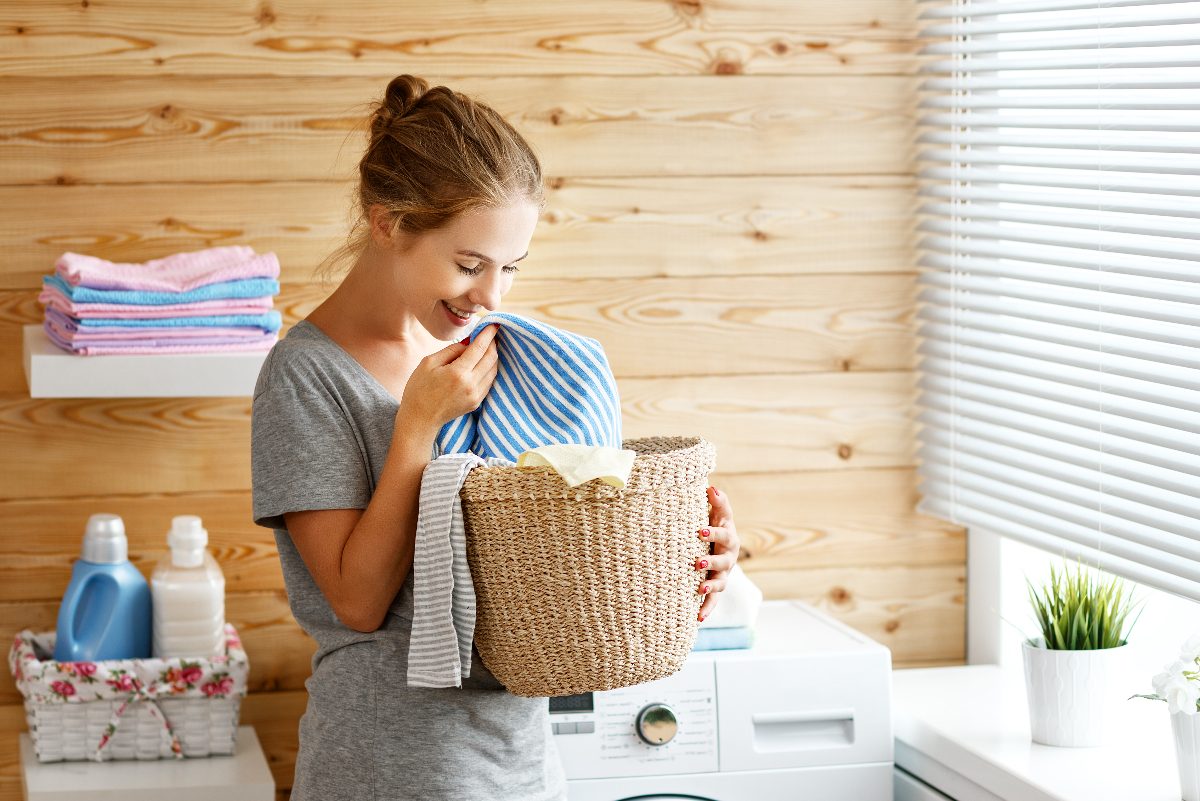
One of the best feelings when it comes to crossing chores off the to-do list is being all caught up with your laundry. Sleeping in crisp sheets, having fresh clothes readily available in your closets and drawers, and bundling up in a soft, fluffy bath towel after showering can instantly upgrade your day. But before you shower and grab that wholesome, fluffy towel to dry yourself off, brace yourself. You may not like what we're about to tell you.
Did you know that there may be living bacteria in your washing machine, and your towels and clothes can be absolutely covered in germs? According to a study published in the journal Frontiers in Microbiology, many habits you do naturally when it comes to addressing dirty laundry have been found to negatively impact the sanitary quality of what you wash, potentially causing bacteria to live and even grow. Listen up, because this is pretty concerning—and not to mention, disgusting. Read on to learn more about the bacteria in your washing machine, and next, check out The 6 Best Exercises for Strong and Toned Arms in 2022, Trainer Says.
A shocking study reveals your "clean" clothes and sheets may still have bacteria all over them
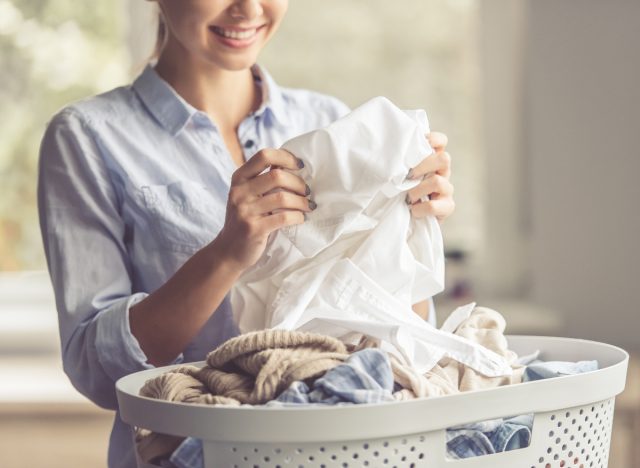
The published research states, "Household washing machines (WMs) launder soiled clothes and textiles, but do not sterilize them." (Wait, what?!) You heard that correctly. This study was performed in five households in Belgium to determine the exchange of bacteria that occurs when washing a standard load of laundry together with some added brand-new cotton tees. The households where laundry was observed were all considered healthy, and antibiotic-free for one month or more.
After doing the loads of laundry, researchers found skin-related bacteria, clothes-related bacteria, influent water bacteria, and biofilm-related bacteria in the washing machines. Some of the bacteria was enhanced in the discharged water, but it was found that the cotton sample did not have a high bacteria content. Just about all the types of bacteria found on the cotton sample remained present in the laundered cotton tees. There was a variety of normal clothing and skin related types of bacteria that developed in the cotton t-shirts after washing. Therefore, "smelly" types of bacteria can potentially spread to other items in the load of wash. Germs detected on the load of dirty laundry were found to be a big contributor of the bacteria that was detected in the items after they were washed, and supposedly clean.
Related: The Best Clothes To Wear For A Better Night's Sleep, Expert Says
Why is this happening when you are washing your clothes with laundry detergent?
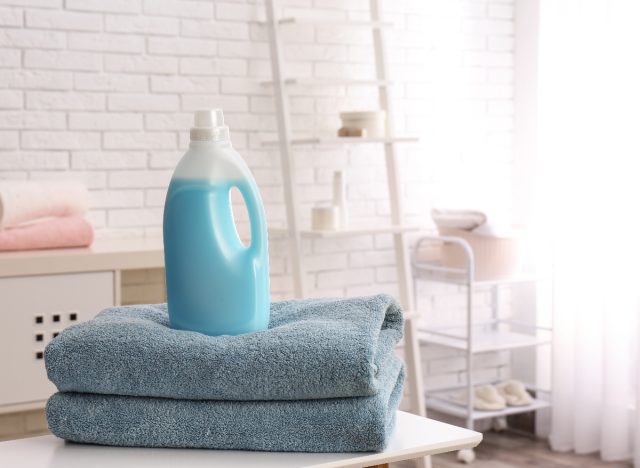
Well, there's a logical reason, or several reasons, why this is happening when you wash your clothes. Just think about it—when you fill up your washing machine with dirty clothes and linens, you're basically stuffing the appliance with bacteria. You naturally expect that everything will come out looking clean and being completely sanitized, right? Well, think again.
Over the years, your entire process of doing laundry has changed drastically, both economically and environmentally. Today, there is much less water used in machines, we use lower temperatures, and there are many changes that have been made in detergents for our ecosystem. There is also less bleach used in most households, the study notes. All of these tweaks to our laundry routines have greatly compromised the sanitary content of everything we wash.
95% of American households don't use water that's hot enough to be properly hygienic
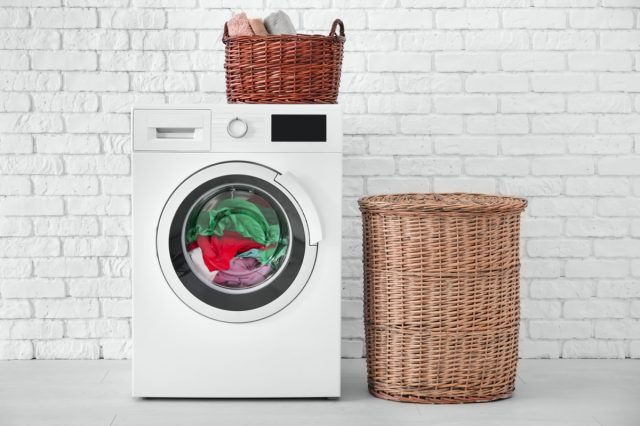
The study further notes 95% of American households do not use water that's hot enough to be properly hygienic, which should actually be 60°C (140°F) or higher. Anything less than that temp can quite possibly be a breeding ground for bacteria in your washing machine, in addition to the cross-contamination of your clothes and linens. A water temp of 50°C (122°F) can cause bacteria to grow, such as S. epidermidis and Staphylococcus aureus, in the trusty appliance that you rely on to get your clothes clean and fresh. (Just so you know, S. aureus causes soft tissue and skin infections such as boils, abscesses, and swollen skin.)
Related: Poor Personal Hygiene Habits That Can Impact Your Lifespan
If your water temp is 40°C (104°F), you need to use a bleach with the laundry detergent to disinfect your laundry
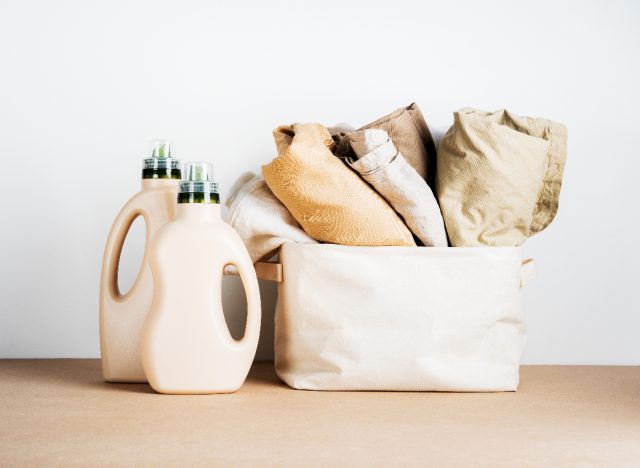
Note that if your water temp is 40°C (104 °F), you really have to use a bleach in or with the laundry detergent—one that is peroxide and chlorine-based, or most commonly sodium hypochlorite. When temperatures are lower, any bleach doesn't even work. Interestingly, using a slow drying process can increase the growth of bacteria quite a bit, adding an unpleasant smell in your seemingly "clean clothes."
According to the study, most laundry detergents available for purchase are made to remove stains and dirt, but not to sanitize. In fact, detergents are not effective in killing biofilms, which are the germs that survive and accumulate in your machine because of its plastic components. These biofilms have proven to hold a variety of potential viruses or bacteria "sometimes even considerably more than toilets," the study notes. These potential viruses include Pseudomonas aeruginosa (which, according to the Centers for Disease Control and Prevention, can be majorly antibiotic-resistant) and Klebsiella pneumoniae, which is an environmental bacteria associated to pneumonia.
So, what changes should you implement when doing your laundry?

According to an article published by the University of Arizona during COVID-19 sterilization, Kelly Reynolds, professor and chair of the Community, Environment and Policy Department at the Mel and Enid Zuckerman College of Public Health explains, "Most studies on how laundry practices kill germs are based on European wash conditions where higher water temperatures and longer wash cycles are common. Hot water washes, however, use a lot of energy and can damage many of today's fabrics." As we've learned, hot water temps are effective in killing more bacteria. Sometimes, however, garments can get ruined in higher temps.
Charles Gerba, an environmental microbiologist from the UArizona College of Agriculture and Life Sciences recommends that you do an empty wash load with bleach or another sanitizer to clean it thoroughly. Gerba explains this can get rid of germs and bacteria that remain in your washer and drum that can contaminate the next batch of clothes you wash.









